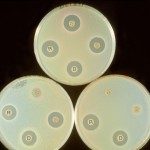Lien vers Pubmed [PMID] – 21159796
RNA 2011 Feb;17(2):251-62
Aminoglycosides are ribosome-targeting antibiotics and a major drug group of choice in the treatment of serious enterococcal infections. Here we show that aminoglycoside resistance in Enterococcus faecium strain CIP 54-32 is conferred by the chromosomal gene efmM, encoding the E. faecium methyltransferase, as well as by the previously characterized aac(6′)-Ii that encodes a 6′-N-aminoglycoside acetyltransferase. Inactivation of efmM in E. faecium increases susceptibility to the aminoglycosides kanamycin and tobramycin, and, conversely, expression of a recombinant version of efmM in Escherichia coli confers resistance to these drugs. The EfmM protein shows significant sequence similarity to E. coli RsmF (previously called YebU), which is a 5-methylcytidine (m⁵C) methyltransferase modifying 16S rRNA nucleotide C1407. The target for EfmM is shown by mass spectrometry to be a neighboring 16S rRNA nucleotide at C1404. EfmM uses the methyl group donor S-adenosyl-L-methionine to catalyze formation of m⁵C1404 on the 30S ribosomal subunit, whereas naked 16S rRNA and the 70S ribosome are not substrates. Addition of the 5-methyl to C1404 sterically hinders aminoglycoside binding. Crystallographic structure determination of EfmM at 2.28 Å resolution reveals an N-terminal domain connected to a central methyltransferase domain that is linked by a flexible lysine-rich region to two C-terminal subdomains. Mutagenesis of the methyltransferase domain established that two cysteines at specific tertiary locations are required for catalysis. The tertiary structure of EfmM is highly similar to that of RsmF, consistent with m⁵C formation at adjacent sites on the 30S subunit, while distinctive structural features account for the enzymes’ respective specificities for nucleotides C1404 and C1407.

